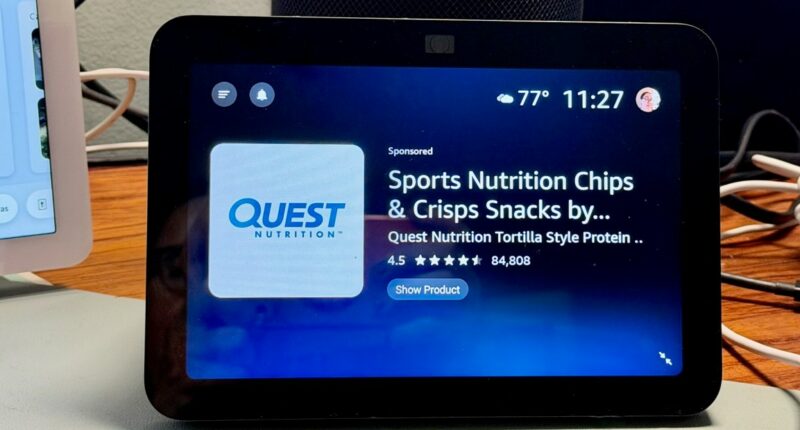Share this @internewscast.com
Last week, Amazon unveiled a significant update to its Alexa-enabled Echo smart speakers and displays. This redesign, overseen by ex-Microsoft design chief Ralf Groene and encouraged by Amazon Devices & Services head Panos Panay, introduced two new Echo Show smart displays. Panay sees these new models as the first step toward crafting “products that customers love.”
But there’s one big barrier to customers loving their Echo Shows: ads.
The Echo Show has become a rotating billboard in my office
Recently, users have started noticing full-screen display ads labeled “sponsored” on their existing Echo Shows, which has sparked discontent. These ads have begun appearing on my device too, and they are quite disruptive, showing up between photos when in Photo Frame mode or interrupting content such as music, recipes, and news.
For instance, as I write this, my Echo Show 8 displayed an ad for an herbal supplement between a picture of my daughter dancing at a wedding and a baby photo of my son. The ad surfaced again two pictures later and continued reappearing.


While advertising isn’t new to Alexa on Echo devices, previously limited to Alexa’s “By the way” feature and the adjustable Shopping category, it has never been this overt.
With these “sponsored” ads becoming more common, it feels misleading. Nothing on the packaging warned that it was an ad-supported product. Unlike Kindles, there’s no purchase discount for an Echo Show with ads. Due to their persistence, these ads are more intrusive than the occasional product suggestion Alexa might make. (Though that itself can be bothersome, this is far more intrusive.)
Additionally, Alexa Plus, the major update to the voice assistant, is now also featuring full-screen ads for its services. Consequently, the Echo Show has turned into a revolving billboard in my workspace.
While currently the ad programming seems to be limited — they haven’t appeared on any other Show devices I have, and some Reddit users report that they don’t see them at all — it’s clear they’re coming. I first heard about full-screen ads appearing in the wild several months ago from a reader who sent me pictures of their Show 15 displaying one. Then, last month, the Alexa subreddit exploded with complaints about them. Many are reporting they’ve unplugged their Shows, and some are claiming to have successfully received refunds from Amazon after complaining about the ads.

At Amazon’s hardware event last month, I asked Panay how ads fit into his mission to build products customers love. He said that if it’s relevant, it’s not an ad, “it’s an add-on.” “There are moments on the product where ads aren’t always bad,” he told me, explaining that if the customer is looking for something specific, and the ad gets them to that faster, it can be a good thing. However, he conceded that some of “the randomness” of the current ad experiences is not great. “It’s about how you elegantly make sure you’re elevating the information that a customer needs.”
My experience of these ads has not been that they’re an “add-on.” They’re intrusive and annoying, showing me products I’m not even slightly interested in, such as elderberry herbal supplements, Quest sports chips, and tabletop picture frames. (Well, the last one might be an option if I remove the Show from my desk.) And, unlike some of the previous ad experiences on the Show, they cannot be turned off.
“If customers don’t like a suggestion, they can swipe to skip to the next screen card”
I asked Amazon if they can be disabled, and spokesperson Lauren Raemhild replied via email, saying, “Advertising is a small part of the experience, and it helps customers discover new content and products they may be interested in. If customers don’t like a suggestion, they can swipe to skip to the next screen card, or directly provide feedback by tapping the Information icon or pressing the screen.”
I tried this, selected “irrelevant ad” from the list of suggested feedback, and got a message saying it had “paused the ad.” But that didn’t stop another ad from appearing. Echo Show users have been trying all sorts of workarounds — from switching to Canadian English (the ads aren’t in Canada — yet) to enabling Kids Mode. But ultimately, if you have to hobble a device to make it usable, why use it at all?
I believe the smart home has a lot of potential, but the current landscape is increasingly feeling like a collection of compromises. Amazon has a very good voice assistant, but can’t stop trying to sell you stuff. Google occasionally reminds itself that it has a smart home division, but my faith in its continued existence is slim. Apple Home is the best experience, but it’s expensive, locked in, and, well, Siri. Yes, there are other solutions available — Home Assistant, SmartThings — but these require more work than most people are willing to put in, and their voice-control options are limited compared to the competition.
With Alexa Plus, the long-promised ambient smart home is finally within reach. It’s time for Amazon to focus on delivering real value — and stop trying to sell us out.








